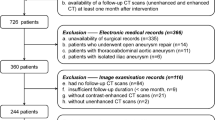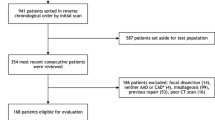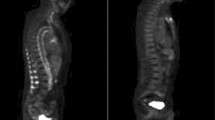Abstract
Objective
To develop a non-contrast CT-based radiomic signature to effectively screen for thoracic aortic dissections (ADs).
Methods
We retrospectively enrolled 378 patients who underwent non-contrast chest CT scans along with CT angiography or MRI from 4 medical centers. The training and validation sets were from 3 centers, while the external test set was from a 4th center. Radiomic features were extracted from non-contrast CT images. The radiomic signature was created on the basis of selected features by a logistic regression algorithm. The area under the curve (AUC) of the receiver operating characteristic (ROC) curve, accuracy, sensitivity, specificity, positive predictive value (PPV), and negative predictive value (NPV) were conducted to assess the predictive ability of radiomic signature.
Results
The radiomic signature demonstrated AUCs of 0.91 (95% confidence interval [CI], 0.86–0.95) in the training set, 0.92 (95% CI, 0.86–0.98) in the validation set, and 0.90 (95% CI, 0.82–0.98) in the external test set. The predicted diagnosis was in good agreement with the probability of thoracic AD. In the external test group, the diagnostic accuracy, sensitivity, specificity, PPV, and NPV were 90.5%, 85.7%, 91.7%, 70.6%, and 96.5%, respectively.
Conclusions
A radiomic signature based on non-contrast CT images can effectively predict thoracic ADs. This method may serve as a potential screening tool for thoracic ADs.
Key Points
• The non-contrast CT-based radiomic signature can effectively predict the thoracic aortic dissections.
• This radiomic signature shows better predictive performance compared to the current clinical model.
• This prediction method may be a potential tool for screening thoracic aortic dissections.





Similar content being viewed by others
Abbreviations
- AD:
-
Aortic dissections
- AUC:
-
Area under the curve
- CI:
-
Confidence interval
- CT:
-
Computed tomography
- ESC:
-
European Society of Cardiology
- GLCM:
-
Gray-level co-occurrence matrix
- ICC:
-
Interclass correlation coefficients
- LASSO:
-
Least absolute shrinkage and selection operator
- MRI:
-
Magnetic resonance imaging
- mRMR:
-
Max-Relevance and Min-Redundancy
- NPV:
-
Negative predictive value
- PPV:
-
Positive predictive value
- Rad-score:
-
Radiomics score
- ROC:
-
Receiver operating characteristic
- ROI:
-
Region of interest
- TOE:
-
Transesophageal echocardiography
- TTE:
-
Transthoracic echocardiography
References
Gawinecka J, Schonrath F, von Eckardstein A (2017) Acute aortic dissection: pathogenesis, risk factors and diagnosis. Swiss Med Wkly 147:w14489
Clouse WD, Hallett JW, Schaff HV et al (2004) Acute aortic dissection: population-based incidence compared with degenerative aortic aneurysm rupture. Mayo Clin Proc 79:176–180
Golledge J, Eagle KA (2008) Acute aortic dissection. Lancet 372:55–66
Meszaros I, Morocz J, Szlavi J et al (2000) Epidemiology and clinicopathology of aortic dissection. Chest 117:1271–1278
Prêtre R, Von Segesser LK (1997) Aortic dissection. Lancet 349:1461–1464
Hagan PG, Nienaber CA, Isselbacher EM et al (2000) The International Registry of Acute Aortic Dissection (IRAD): new insights into an old disease. JAMA 283:897–903
Trimarchi S, Nienaber CA, Rampoldi V et al (2005) Contemporary results of surgery in acute type A aortic dissection: the International Registry of Acute Aortic Dissection experience. J Thorac Cardiovasc Surg 129:112–122
Shiga T, Wajima Z, Apfel CC, Inoue T, Ohe Y (2006) Diagnostic accuracy of transesophageal echocardiography, helical computed tomography, and magnetic resonance imaging for suspected thoracic aortic dissection: systematic review and meta-analysis. Arch Intern Med 166:1350–1356
Erbel R, Aboyans V, Boileau C et al (2014) 2014 ESC Guidelines on the diagnosis and treatment of aortic diseases: document covering acute and chronic aortic diseases of the thoracic and abdominal aorta of the adult. The Task Force for the Diagnosis and Treatment of Aortic Diseases of the European Society of Cardiology (ESC). Eur Heart J 35:2873–2926
Salmasi MY, Al-Saadi N, Hartley P et al (2020) The risk of misdiagnosis in acute thoracic aortic dissection: a review of current guidelines. Heart 106:885–891
Kurabayashi M, Okishige K, Ueshima D et al (2014) Diagnostic utility of unenhanced computed tomography for acute aortic syndrome. Circ J 78:1928–1934
Lambin P, Rios-Velazquez E, Leijenaar R et al (2012) Radiomics: extracting more information from medical images using advanced feature analysis. Eur J Cancer 48:441–446
Gillies RJ, Kinahan PE, Hricak H (2016) Radiomics: images are more than pictures, they are data. Radiology 278:563–577
Oikonomou EK, Siddique M, Antoniades C (2020) Artificial intelligence in medical imaging: a radiomic guide to precision phenotyping of cardiovascular disease. Cardiovasc Res 116:2040–2054
Ganeshan B, Miles KA (2013) Quantifying tumour heterogeneity with CT. Cancer Imaging 13:140–149
Davnall F, Yip CS, Ljungqvist G et al (2012) Assessment of tumor heterogeneity: an emerging imaging tool for clinical practice? Insights Imaging 3:573–589
Li H, Xie Y, Wang X, Chen F, Sun J, Jiang X (2019) Radiomics features on non-contrast computed tomography predict early enlargement of spontaneous intracerebral hemorrhage. Clin Neurol Neurosurg 185:105491
Ma C, Zhang Y, Niyazi T et al (2019) Radiomics for predicting hematoma expansion in patients with hypertensive intraparenchymal hematomas. Eur J Radiol 115:10–15
Giddens DP, Mabon RF, Cassanova RA (1976) Measurements of disordered flows distal to subtotal vascular stenoses in the thoracic aortas of dogs. Circ Res 39:112–119
Cheng Z, Tan FP, Riga CV et al (2010) Analysis of flow patterns in a patient-specific aortic dissection model. J Biomech Eng 132:051007
New PF, Aronow S (1976) Attenuation measurements of whole blood and blood fractions in computed tomography. Radiology 121:635–640
Yushkevich PA, Piven J, Hazlett HC et al (2006) User-guided 3D active contour segmentation of anatomical structures: significantly improved efficiency and reliability. Neuroimage 31:1116–1128
Minnich DJ, Mathisen DJ (2007) Anatomy of the trachea, carina, and bronchi. Thorac Surg Clin 17:571–585
Dessau RB, Pipper CB (2008) “R”- project for statistical computing. Ugeskr Laeger 170:328–330
Bluemke DA, Moy L, Bredella MA et al (2020) Assessing radiology research on artificial intelligence: a brief guide for authors, reviewers, and readers-from the radiology editorial board. Radiology 294:487–489
Carroll BJ, Schermerhorn ML, Manning WJ (2020) Imaging for acute aortic syndromes. Heart 106:182–189
Shiga T, Wajima Z, Inoue T, Ogawa R (2003) Survey of observer variation in transesophageal echocardiography: comparison of anesthesiology and cardiology literature. J Cardiothorac Vasc Anesth 17:430–442
Demos TC, Posniak HV, Churchill RJ (1986) Detection of the intimal flap of aortic dissection on unenhanced CT images. AJR Am J Roentgenol 146:601–603
Yamada T, Tada S, Harada J (1988) Aortic dissection without intimal rupture: diagnosis with MR imaging and CT. Radiology 168:347–352
Lovy AJ, Rosenblum JK, Levsky JM et al (2013) Acute aortic syndromes: a second look at dual-phase CT. AJR Am J Roentgenol 200:805–811
Castañer E, Andreu M, Gallardo X, Mata JM, Cabezuelo MA, Pallardó Y (2003) CT in nontraumatic acute thoracic aortic disease: typical and atypical features and complications. Radiographics 23 Spec No:S93–110. https://doi.org/10.1148/rg.23si035507
Freis ED, Heath WC (1964) Hydrodynamics of aortic blood flow. Circ Res 14:105–116
Thubrikar MJ, Agali P, Robicsek F (1999) Wall stress as a possible mechanism for the development of transverse intimal tears in aortic dissections. J Med Eng Technol 23:127–134
Klipstein RH, Firmin DN, Underwood SR, Rees RS, Longmore DB (1987) Blood flow patterns in the human aorta studied by magnetic resonance. Br Heart J 58:316–323
Kohn MA, Kwan E, Gupta M, Tabas JA (2005) Prevalence of acute myocardial infarction and other serious diagnoses in patients presenting to an urban emergency department with chest pain. J Emerg Med 29:383–390
Funding
This study has received funding by the National Natural Science Foundation of China (No. 81971600) and the Zhejiang Provincial Natural Science Foundation of China (LSY19H180003).
Author information
Authors and Affiliations
Corresponding authors
Ethics declarations
Guarantor
The scientific guarantor of this publication is Zhichao Sun.
Conflict of interest
The authors of this manuscript declare relationships with the following companies: GE Healthcare. Peipei Pang contributed to the development of radiomics models described in the study.
Statistics and biometry
One of the authors (Peipei Pang) has significant statistical expertise.
Informed consent
Written informed consent was waived by the Institutional Review Board.
Ethical approval
Institutional Review Board approval was obtained.
Methodology
• Retrospective
• Diagnostic or prognostic study
• Multicenter study
Additional information
Publisher’s note
Springer Nature remains neutral with regard to jurisdictional claims in published maps and institutional affiliations.
Zhichao Sun is the first corresponding author and Maosheng Xu is the second corresponding author of this work.
Supplementary Information
ESM 1
(DOCX 43 kb)
Rights and permissions
About this article
Cite this article
Guo, Y., Chen, X., Lin, X. et al. Non-contrast CT-based radiomic signature for screening thoracic aortic dissections: a multicenter study. Eur Radiol 31, 7067–7076 (2021). https://doi.org/10.1007/s00330-021-07768-2
Received:
Revised:
Accepted:
Published:
Issue Date:
DOI: https://doi.org/10.1007/s00330-021-07768-2




